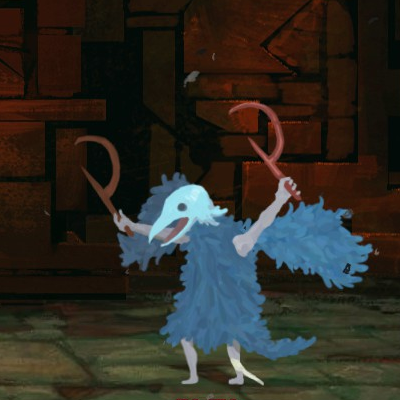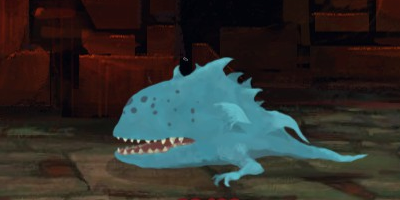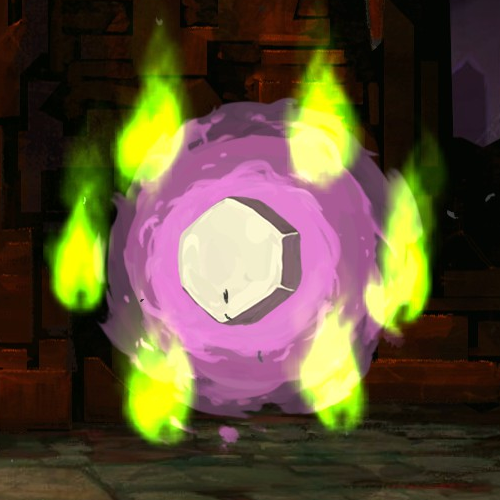Slaying the Spire Pt. I
Slay the Spire is a very excellent digital deck-building strategy/adventure game developed by MegaCrit, a small studio out of my hometown of Seattle, WA. If you haven't heard of the game, but are a fan of card games, strategy games, or even just good, good games in general, I highly recommend checking it out on Steam—I've definitely found it to be more than worth the full purchase price already.
In any event, Slay the Spire also has wonderfully imaginative designs for both its monsters and its magic items (or "relics" as they are referred to in the game). So obviously, I felt the need to stat a bunch of them into D&D.
The game begins at the bottom of the titular spire, where you then climb upwards floor by floor, facing increasingly difficult challenges as you go. So for this first part, I start at the beginning: The three character's starting relics, and the creatures found in Act 1.
Relics as Magic Items
Relics in Slay the Spire function much the same as D&D's magic items, though because the mechanics concerning armor, health, poison, and many other elements differ significantly between these two games, some creative liberties need to be taken to get them to serve their intended purpose effectively. However, the changes made are only as little as is necessary to replicate the proper effect.
Starter Relics
Relics are treated identically to magic items, such that the two terms are interchangeable. Relics are presented in alphabetical order. A relic's description gives the item's name, its category, its rarity, and its magical properties.
Burning Blood Amulet
Wondrous item, rare (requires attunement)
When you exit initiative after you or your allies have reduced at least one hostile creature to 0 hit points, you regain 2d4 hit points. Afterwards, the amulet doesn't function for 1 hour.
Cracked Orb Circlet
Wondrous item, rare (requires attunement)
When you roll initiative and you are not surprised, you conjure a small mote of lightning which orbits your space for the next 1 minute. At the end of each of your turns while this lightning mote orbits you, it makes a melee spell attack against a random hostile creature within 10 feet of you. The bonus to the attack roll is equal to your proficiency bonus, and the attack deals 1d6 lightning damage on a hit.
While the lightning mote orbits you, you can spend a bonus action to consume it and make a melee spell attack against a target you can see within 10 feet of you. The bonus to the attack roll is equal to three times your proficiency bonus, and the attack deals 3d6 lightning damage on a hit. If you consume the lightning mote in this way, the cracked core circlet doesn't function until the next dawn.
Ring of the Snake
Ring, rare (requires attunement)
After rolling initiative, if you are not surprised, you can take one additional bonus action on top of your regular action and a possible bonus action on your first turn in combat. In this case, your speed also increases by 5 feet, and you have advantage on ability checks and saving throws that use Dexterity for the remainder of your first turn.
Monsters and NPCs
The people and creatures which reside within the spire that touches the sky are of a different sort indeed. Across many of its hundreds—if not thousands—of floors, you're just as likely to encounter a ravenous beast of unworldly origin as you are an average person.
Listed here is just a small collection of some of the adversaries you may encounter should you be so bold (or foolish) to attempt the climb.
Act I: Exordium
The base of the massive spire is called The Exordium. Cavernous, yet unsettlingly sepulchral halls and chambers make up the majority of this section, which is inhabited by all kinds of strange and dangerous beasts and ne'er-do-wells.
Spire Cultists
The entire expanse of the spire is home to and base of operations for a distinctive cult that is as bizarre as it is pervasive. The cultists are easily identified by their rough feathered costumes, full-faced bird masks, and pair of rusted ceremonial sickles. They speak in a characteristic, piercing tone of voice, reminiscent of the cry of a large bird, particularly when performing their strange rituals, some of which seem to manifest actual deific powers.

Spire Cultist
Medium humanoid (any race), neutral evil
Armor Class 13 (padded armor)
Hit Points 26 (4d8 + 8)
Speed 30 ft.
STR DEX CON INT WIS CHA 13 (+1) 14 (+2) 14 (+2) 8 (-1) 10 (+0) 10 (+0)
Senses passive Perception 10
Languages Common, one other
Challenge 1 (200 XP)
Dark Devotion. The cultist has advantage on saving throws against being charmed or frightened.
Actions
Multiattack. The cultist makes two sickle attacks.
Sickle. Melee Weapon Attack: +3 to hit, reach 5 ft., one target. Hit: 3 (1d4 + 1) slashing damage.
Ritual (1/Day). The cultist chants and gesticulates in a petition to its mysterious deity, becoming empowered for the next 1 minute. While the cultist is empowered, its Strength score increases by 3 at the start of each of its turns (to a maximum of 22). After 1 minute, the cultist's Strength score returns to its normal value, and the cultist gains one level of exhaustion.
Giant Lice
The giant lice found the exordium of the spire are not just unusual in their size. The furry, almost caterpillar-like creatures prey on isolated creatures, even those much larger than themselves. Either by immobilizing prey with their silken webs, or growing in size to match that of their potential meal, they attack without fear or any apparent sense of self-preservation.
Red and Green Giant Lice
There are two similar, but distinct species of giant lice: red and green. Both species use the game statistics seen here, but only red lice possess the Grow action. Likewise, only green lice possess the Web action.
Giant Louse
Small beast, unaligned
Armor Class 12 (natural armor)
Hit Points 18 (4d6 + 4)
Speed 20 ft., climb 20 ft.
STR DEX CON INT WIS CHA 6 (-2) 13 (+1) 15 (+2) 2 (-4) 11 (+0) 4 (-3)
Skills Perception +2, Stealth +3
Senses darkvision 60 ft., passive Perception 12
Languages —
Challenge 1/4 (50 XP)
Spider Climb. The louse can climb difficult surfaces, including upside down on ceilings, without needing to make an ability check.
Actions
Bite. Melee Weapon Attack: +3 to hit, reach 5 ft., one target. Hit: 4 (1d6 + 1) piercing damage.
Grow (1/Day; Red Louse Only). Through a mysterious biological process, The louse temporarily increases its size. For the next 1 minute, the louse's size doubles in all dimensions, and its weight is multiplied by eight. This growth increases the louse's size by one category—from Small to Medium, for example. If there isn’t enough room for the louse to double its size, it attains the maximum possible size in the space available. For the duration, the louse also has advantage on Strength checks and Strength saving throws. While enlarged, the louse’s weapon attacks deal 1d4 extra damage of the same type.
Web (Recharge 5–6; Green Louse Only). Ranged Weapon Attack: +3 to hit, range 30/60 ft., one creature. Hit: The target is restrained by webbing. As an action, the restrained target can make a DC 12 Strength check, bursting the webbing on a success. The webbing can also be attacked and destroyed (AC 10; hp 5; vulnerability to fire damage; immunity to bludgeoning, poison, and psychic damage).
Reactions
Curl Up (Recharges After a Short or Long Rest). When the louse takes damage, it curls up, protecting the unarmored portions of its body. Until the start of the louse's next turn, its AC increases by 5, its speed becomes 0, and it can't benefit from increases to speed.
Jaw Worm
Jaw worms are belching, crawling mockeries of life which are found nowhere outside of the spire's walls. It is unknown if the creatures were created within the spire, if they were brought there, or if they even somehow evolved there. The creatures appear aberrant in their biology, but it is unclear why an aberration would manifest only within one specific structure, as auspicious as that structure might be.
However, While much about these vicious monsters remains a mystery, it is common knowledge that seeing one is almost invariably proceeded by an attack.

Jaw Worm
Medium aberration, unaligned
Armor Class 13 (natural armor)
Hit Points 51 (6d8 + 24)
Speed 30 ft.
STR DEX CON INT WIS CHA 17 (+3) 12 (+1) 16 (+3) 2 (-4) 10 (+0) 6 (-2)
Senses blindsight 60 ft. (blind beyond this radius), passive Perception 10
Languages —
Challenge 2 (450 XP)
Keen Smell. The jaw worm has advantage on Wisdom (Perception) checks that rely on smell.
Actions
Bite. Melee Weapon Attack: +3 to hit, reach 5 ft., one target. Hit: 8 (1d10 + 3) piercing damage.
Aggressive Rush (Recharge 5–6). The Jaw worm gains 10 temporary hit points. The jaw worm then immediately moves up to its speed in a straight line to a space within 5 feet of a creature it can see, making a bite attack against that creature with advantage.
Bellow (Recharge After a Short or Long Rest). The jaw worm lets out a resounding bellow. Each creature that is not a jaw worm within 30 feet of it that can hear it must succeed on a DC 13 Wisdom saving throw or become frightened of any jaw worms it sees for 1 minute. A frightened creature deals half damage with weapon and spell attacks against any jaw worm, and the creature can repeat its save at the end of each of its turns, ending the effect on a success.
Fungal Beast
This insidious fungus grows from the corpses of vermin or other tiny creatures—usually those killed by its kin—assuming the body and ambling around on small sinewy lashes in a truly macabre display.
While individually these creatures aren't terribly dangerous, they are rarely encountered alone. Colonies of dozens, if not hundreds of fungal beasts have been found in the depths of the exordium. In such vastly superior numbers, it's not uncommon for these small beings to overwhelm and consume prey even much larger than themselves.
Fungal Beast
Small plant, unaligned
Armor Class 10
Hit Points 11 (2d6 + 4)
Speed 20 ft.
STR DEX CON INT WIS CHA 13 (+1) 10 (+0) 15 (+2) 1 (-5) 6 (-2) 2 (-4)
Skills Perception +0
Damage Immunities poison
Condition Immunities blinded, poisoned
Senses tremorsense 30 ft. (blind beyond this radius), passive Perception 10
Languages —
Challenge 1/8 (25 XP)
Spore Explosion. When the fungal beast dies, it releases an opaque cloud of spores in a 10-foot radius area which lasts for 1 round. Each living creature that enters the area for the first time on its turn or starts its turn there must succeed on a DC 12 Constitution saving throw or become poisoned for 1 minute. A creature poisoned by this cloud is blinded and vulnerable to slashing damage.
A creature poisoned by the cloud can repeat its save at the end of each of its turns, ending the effects on a success.Actions
Tendril Whip. Melee Weapon Attack: +3 to hit, reach 5 ft., one target. Hit: 3 (1d4 + 1) slashing damage, and if the target is a Medium or smaller creature, it is grappled (escape DC 11).
Hexaghost
Virtually nothing is known about this huge, roving spirit—or collection of spirits—occasionally seen in the exordium, other than its apparent affinity for the number six.
The hexaghost is an entity of widely varying temperament. While some sightings of it describe a slow-moving, somber presence, many others paint scenes of burning hot rage and unprovoked violence.
A large hexagonally-shaped chunk of crystal or marble appears to float within the hexaghost's core, but it is impossible to tell if this is actually a solid object, or merely some kind of ghostly image manifested by the ghost for some inscrutable purpose.
When aroused, the hexaghost conjures spectral floating motes of flame, which circle it with increasing speed. Once the ghost conjures six of these flames, it releases a devastating beam of flame which has, on more than one occasion, reduced a formidable group of warriors to nothing more than ashes.

Hexaghost
Huge undead, neutral evil
Armor Class 9
Hit Points 189 (18d12 + 72)
Speed 0 ft., fly 40 ft. (hover)
STR DEX CON INT WIS CHA 7 (-2) 8 (-1) 19 (+4) 10 (+0) 15 (+2) 21 (+5)
Saving Throws Con +7, Wis +6
Damage Resistances acid, cold, lightning, thunder; bludgeoning, piercing, and slashing from nonmagical attacks
Damage Immunities fire, necrotic, poison
Condition Immunities charmed, exhaustion, frightened, grappled, paralyzed, petrified, poisoned, prone, restrained
Senses darkvision 120 ft., passive Perception 10
Languages understands Common but can't speak
Challenge 11 (7,200 XP)
Ethereal Sight. The hexaghost can see 60 feet into the Ethereal Plane when it is on the Material Plane, and vice versa.
Incorporeal Movement. The hexaghost can move through other creatures and objects as if they were difficult terrain. It takes 5 (1d10) force damage if it ends its turn inside an object.
Hexflames. The hexaghost surrounds itself with up to six spectral floating hexflames, each of which shed light as a torch would, and which can't be extinguished except by the hexaghost. The hexaghost begins combat with all six of its hexflames lit, and when the hexaghost dies, all of its hexflames disappear.
While at least one of the hexaghost's hexflames is lit, when a creature moves to within 5 feet of the hexaghost for the first time on its turn or starts its turn there, the creature must succeed on a Dexterity saving throw or take 1d6 fire damage for each lit hexflame. The DC of this saving throw is equal to 11 plus the number of lit hexflames the hexaghost possesses.
Actions
Multiattack. The hexaghost can use its inflame, if recharged. It then makes three flare attacks, any one of which can be replaced with its sear, if recharged.
Flare. Melee or Ranged Spell Attack: +9 to hit, reach 10 ft. or range 90 ft., one target. Hit: 14 (4d6) fire damage, plus an additional 1 fire damage for each of the hexaghost's flames currently lit.
Inflame (Recharge 4–6). The hexaghost energizes itself, lighting one of its six flames.
Sear (Recharge 4–6). One creature within 10 feet of the hexaghost must succeed on a DC 17 Dexterity saving throw or take 21 (6d6) fire damage and become seared. If a seared creature possesses immunity to fire damage, that immunity changes to resistance for as long as it is seared. If a seared creature possesses resistance to fire damage, it instead loses that resistance for as long as it is seared. If a seared creature possesses neither immunity nor resistance to fire damage, it instead gains vulnerability to fire damage.
Inferno (Requires Six Lit Hexflames). The hexaghost's six burning hexflames orbit it furiously, eventually releasing a 15-foot wide, 60-foot long line of searing flame originating from the hexaghost. Each creature within this area must succeed on a DC 17 Dexterity saving throw or take 42 (12d6) fire damage. Immediately after the hexaghost uses this action, all six of its flames are extinguished.